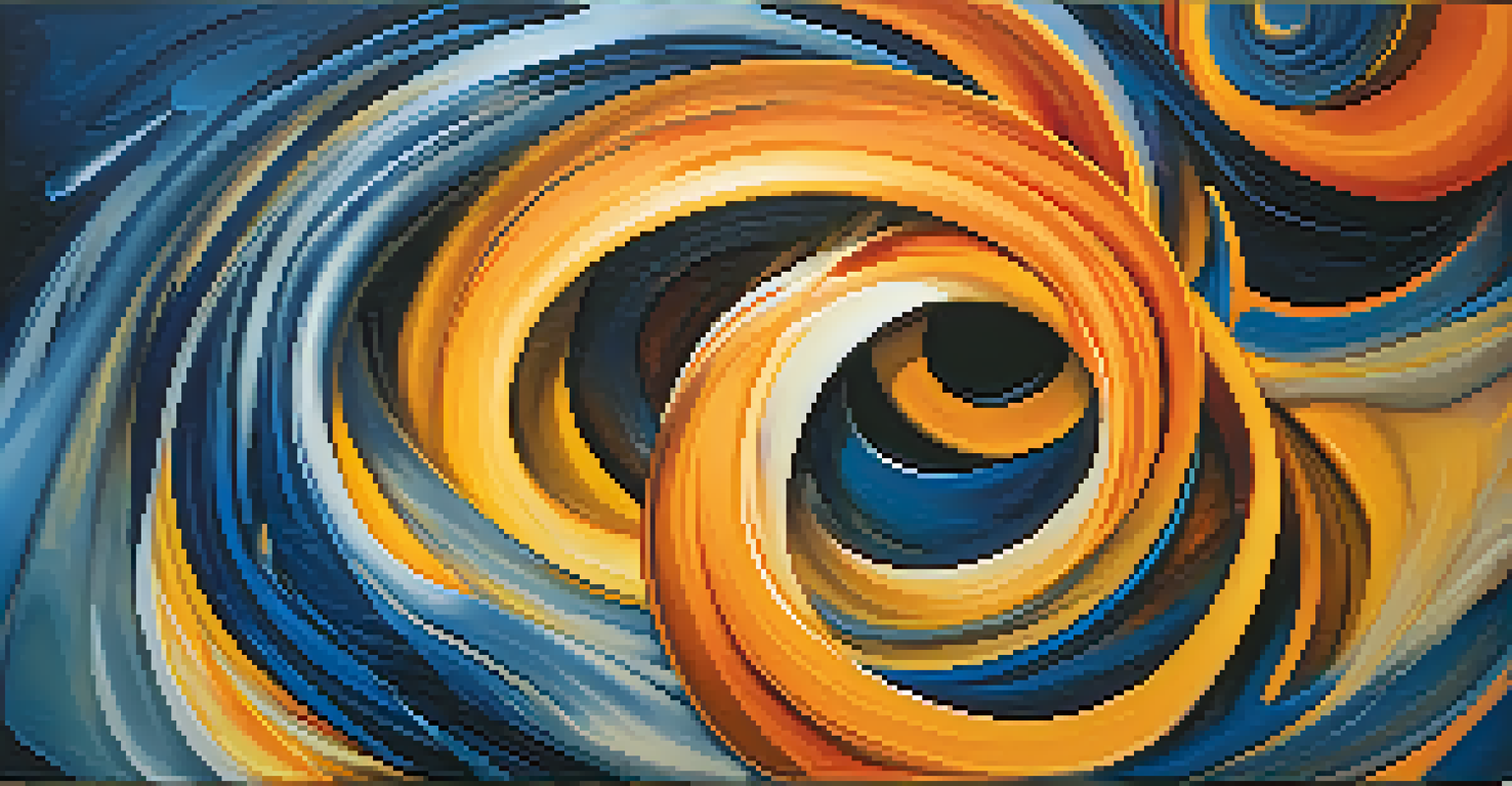The Role of Hallucinogens in Achieving Non-Dual Awareness

Understanding Non-Dual Awareness: A Brief Overview
Non-dual awareness refers to a state of consciousness where the distinction between self and other dissolves. This experience can lead to profound insights about the nature of reality and our place within it. Instead of perceiving the world through a lens of separation, individuals often report a sense of unity and interconnectedness with everything around them.
The greatest discovery of my generation is that a human being can alter his life by altering his attitude.
Many spiritual traditions have long emphasized the importance of achieving non-dual awareness. Practices such as meditation, yoga, and mindfulness aim to cultivate this state by quieting the mind and promoting a deeper connection to the present moment. By understanding non-dual awareness, we can better appreciate the potential role of hallucinogens in facilitating this experience.
As we delve into the relationship between hallucinogens and non-dual awareness, it's essential to recognize that experiences can vary widely from person to person. Factors such as mindset, setting, and individual differences can significantly influence the outcomes of such experiences.
The Science Behind Hallucinogens and Consciousness
Hallucinogens, such as psilocybin and LSD, interact with the brain's serotonin receptors, leading to altered states of consciousness. These substances can enhance sensory perception and evoke profound emotional experiences, which many users describe as life-changing. The brain's default mode network, responsible for self-referential thought, often becomes less active under the influence of these compounds.

This reduction in activity within the default mode network can allow for a shift from a fragmented sense of self to a more unified experience of consciousness. As users journey inward, they may find themselves confronting and integrating aspects of their psyche that were previously hidden or suppressed. This process can be both enlightening and challenging.
Non-Dual Awareness Explained
Non-dual awareness is a state of consciousness where the distinction between self and other dissolves, fostering a sense of unity with everything around us.
Understanding the neurobiological effects of hallucinogens helps to demystify their potential role in achieving non-dual awareness. By exploring how these substances affect brain function, we can better understand the mechanisms that may facilitate the experience of oneness.
Historical Context of Hallucinogens in Spiritual Practices
Throughout history, various cultures have used hallucinogens in spiritual and religious practices. Indigenous peoples in the Amazon, for example, have incorporated ayahuasca into their rituals for centuries, seeking to connect with the spirit world and achieve deeper states of awareness. These traditions highlight the long-standing human fascination with altered states of consciousness.
The mind is everything. What you think you become.
In many cases, these substances were not merely recreational but were seen as sacred tools for insight and healing. The intentional use of hallucinogens during ceremonies often aimed to foster community bonding and personal transformation. This historical context can inform our contemporary understanding of their potential benefits.
As society evolves, the conversation around hallucinogens is gaining renewed interest, especially in the context of mental health and self-exploration. Recognizing the historical significance of these substances can help us approach their modern use with respect and understanding.
Personal Experiences: Hallucinogens and Non-Dual Awareness
Many individuals who have used hallucinogens report experiences that resemble non-dual awareness. These accounts often include feelings of oneness with nature, the universe, or other people. Such transformative experiences can lead to lasting changes in one's perspective on life and relationships.
For example, a person might describe a moment during their trip when they felt completely connected to everything around them, as if their individual consciousness was merging with the cosmos. This sense of unity can dissolve feelings of isolation and foster a deeper appreciation for life. These personal stories highlight the potential of hallucinogens to catalyze significant shifts in consciousness.
Hallucinogens Influence Consciousness
Substances like psilocybin and LSD can alter brain function, potentially facilitating experiences of non-dual awareness by diminishing self-referential thought.
However, it’s important to approach these experiences with caution. The subjective nature of hallucinogenic experiences means that the outcomes can vary widely, and not everyone may achieve a state of non-dual awareness. Understanding both the potential and the limitations of these substances is crucial.
The Role of Set and Setting in Hallucinogenic Experiences
Set and setting refer to the mindset of the individual and the physical and social environment in which the hallucinogen is consumed. These factors play a crucial role in shaping the overall experience and can significantly influence whether someone achieves non-dual awareness. A supportive, safe environment can enhance positive outcomes, while a chaotic or uncomfortable setting may lead to challenging experiences.
Creating an optimal setting involves not only physical surroundings but also emotional readiness. Engaging in practices such as meditation or setting intentions beforehand can help prepare the mind for the journey. Understanding how set and setting interact can empower individuals to make informed choices about their experiences with hallucinogens.
Ultimately, the interplay of set and setting underscores the importance of intentionality in exploring altered states of consciousness. By recognizing how these elements affect our experiences, we can better navigate the complex landscape of hallucinogens and their potential for facilitating non-dual awareness.
Potential Benefits and Risks of Using Hallucinogens
While many individuals report positive experiences with hallucinogens, it's essential to recognize the potential risks involved. Hallucinogens can provoke intense emotions and memories, which might be overwhelming for some users. Additionally, individuals with a history of mental health issues may be at higher risk for adverse reactions, underscoring the need for caution.
On the flip side, numerous studies suggest that hallucinogens can have therapeutic benefits, particularly in treating conditions like PTSD, anxiety, and depression. These substances may help individuals confront and process deeply rooted emotions, leading to transformative insights and healing. It’s this duality of risk and potential that makes discussing hallucinogens so crucial.
Set and Setting Matter
The mindset and environment in which hallucinogens are consumed significantly impact the quality of the experience, influencing the likelihood of achieving non-dual awareness.
Informed and responsible use, often within a therapeutic or guided context, can help mitigate risks while maximizing potential benefits. Understanding both sides of the coin is essential for anyone considering exploring hallucinogens as a pathway to non-dual awareness.
Integrating Non-Dual Awareness into Daily Life
Achieving non-dual awareness, whether through hallucinogens or other means, can have profound implications for daily life. Many individuals find that these experiences lead to a more compassionate and connected way of living. The insights gained can inspire changes in how one interacts with others and perceives the world.
Practices such as mindfulness, meditation, and self-reflection can help integrate the feelings of oneness experienced during hallucinogenic trips into everyday life. By cultivating awareness and presence, individuals can maintain a connection to that sense of unity even after the experience fades. This integration can lead to lasting personal growth and transformation.

In essence, the journey doesn’t end when the effects of the hallucinogen wear off. By actively incorporating the lessons learned and the awareness gained, individuals can foster a deeper appreciation for life and a sense of interconnectedness that enriches their daily experiences.